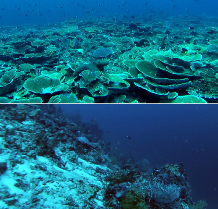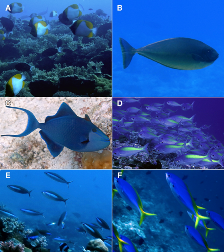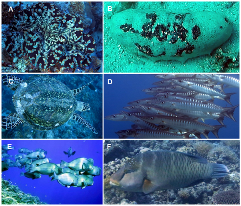An expedition to Apo Reef Natural Park conducted in March 2016 revealed greater reef biodiversity compared to previous surveys. The surveys were implemented by the University of the Philippines-Marine Science Institute (UP-MSI) through the project, Geophysical Coral Mapping (GCM). The project is funded by the Philippine Council for Agriculture, Aquatic and Natural Resources Research and Development of the Department of Science and Technology (DOST-PCAARRD).
The survey added new records of corals, fishes, and megafauna for its shallow reefs or ‘euphotic stations’ and for deeper reefs at 30 to 150 m depths that is referred to as ‘mesophotic zone’ or twilight zone. The twilight zone is dimly lit and can be considered risky for researchers with recreational SCUBA certification and equipment. A remotely operated vehicle (ROV) was used to explore reefs beyond 40 m and to the lower mesophotic zone which is at 60-150 m depths.
 Hard coral genera were documented in nine sites in Apo Reef with 40 from the euphotic stations and 38 from the upper mesophotic stations. Live coral cover was relatively high in the euphotic and mesophotic zones (38% and 29%, respectively). For Porites and other coral genera found in both depth zones, their growth forms were branching or massive in the euphotic zone but were encrusting or foliose at the mesophotic zone. According to GCM researchers, corals adapt these flattened forms to optimize their exposure to light in dim mesophotic conditions.
Hard coral genera were documented in nine sites in Apo Reef with 40 from the euphotic stations and 38 from the upper mesophotic stations. Live coral cover was relatively high in the euphotic and mesophotic zones (38% and 29%, respectively). For Porites and other coral genera found in both depth zones, their growth forms were branching or massive in the euphotic zone but were encrusting or foliose at the mesophotic zone. According to GCM researchers, corals adapt these flattened forms to optimize their exposure to light in dim mesophotic conditions.
 Meanwhile, deep shoals with mesophotic reefs like the Apo 29 (with its shallowest depth at 28 m) had the largest area covered by foliose Montipora corals and differed in community structure compared to fringing reefs around Apo Reef's island.
Meanwhile, deep shoals with mesophotic reefs like the Apo 29 (with its shallowest depth at 28 m) had the largest area covered by foliose Montipora corals and differed in community structure compared to fringing reefs around Apo Reef's island.
Over 208 fish species were recorded in Apo Reef, 170 of which were in the euphotic zone and 104 from the upper mesophotic zone. Over 15 species were newly recorded for mesophotic depths and may be used to update species information. Thirty-five megafaunal species were also recorded in the area, some of which are listed in the International Union for Conservation of Nature (IUCN) Red List of Threatened Species, which include the hawksbill turtle, bumphead parrotfish, Napoleon wrasse, pelagic thresher shark, white teatfish, pineapple sea cucumber, and giant clams.
According to the results of the GCM project, the long-term protection and the large size of the marine protected area (MPA) were the factors in the common occurrence of large mega fauna found in Apo Reef. This finding provides preliminary evidence proving that mesophotic reefs serve as refuge for corals and fishes. Following this, the GCM team recommends that MPAs located in fringing reefs should be extended to cover the mesophotic depths and that submerged reefs or shoals should also be prioritized in MPA site selection.

